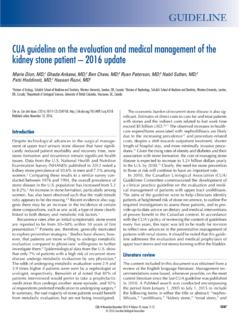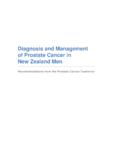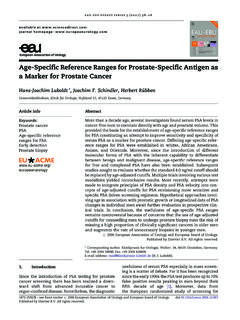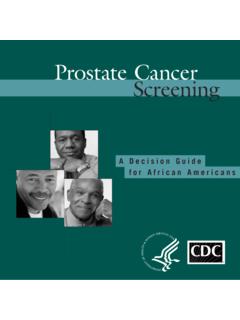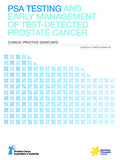Transcription of Canadian Urological Association recommendations on ...
1 CUAJ October 2017 Volume 11, Issue 10 2017 Canadian Urological AssociationCUA GUIDELINE298 Cite as: Can Urol Assoc J 2017;11(10):298-309. related editorial on page 295 IntroductionProstate cancer remains the most commonly diagnosed non-cutaneous malignancy among Canadian men and is the third leading cause of cancer -related death. In 2016, an estimated 21 600 men were diagnosed with prostate cancer and 4000 men died from the disease;1 however, prostate cancer is a heterogeneous disease with a clinical course ranging from indolent to life-threatening. Identifying and treating men with clinically significant prostate cancer while avoiding the over-diagnosis and over-treatment of indolent disease remains a significant challenge. Several professional associations have developed guidelines on prostate cancer screening and early diagnosis, but there are conflicting recommendations on how best to approach these issues. With recent updates from several large, ran-domized, prospective trials, as well as the emergence of several new diagnostic tests, the Canadian Urological Association (CUA) has developed these evidence-based recommendations to guide clinicians on prostate cancer screening and early diagnosis for Canadian men.
2 The aim of these recommendations is to provide guidance on the current best prostate cancer screening and early diagnosis practices and to provide information on new and emerging diagnostic modalities. Evidence synthesis and recommendations developmentIn order to develop these recommendations , the following questions related to prostate cancer screening and diagno-sis were defined, a priori, to guide the specific literature searches and evidence Canadian men undergo prostate cancer screening ? what age should prostate cancer screening begin? can prostate cancer screening be stopped? frequently should prostate cancer screening be performed? diagnostic tests, in addition to prostate -specific antigen (PSA), are available for the early diagnosis of prostate cancer ?The aim of answering the first four questions is to provide guidance on prostate cancer screening in general. The aim of the fifth question is to provide information on additional available tests. Therefore, a different search strategy was used for these questions.
3 For the first four questions, we employed a two-step approach in order to synthesize the best available evidence to develop these recommendations . First, recognizing that several other professional organiza-tions have developed evidence-based guidelines on prostate cancer screening and diagnosis, a complete bibliographic review of existing guidelines on prostate cancer screening and diagnosis was performed. Studies related to questions 1 4 were reviewed at full length. Second, in order to identify studies not captured by existing guidelines, a search of the literature was conducted using MEDLINE to identify articles related to the screening and diagnosis of prostate cancer that were published between January 1, 2016 and February 2, 2017. To identify articles not yet indexed, a search was also performed using PubMed without MEDLINE filters (see Appendix 1 for search strategy). For the fifth question relat-ed to additional diagnostic tests beyond PSA, which can potentially aid in the early detection of prostate cancer , a systematic search was performed in a similar fashion with no date restriction for tests not covered by existing series, case reports, non-systematic reviews, edi-torials, and letters to the editor were excluded and the search strategy was restricted to English language articles.
4 Trained methodologists implemented the specific search Ricardo A. Rendon, MD1; Ross J. Mason, MD2; Karim Marzouk, MD3; Antonio Finelli, MD4; Fred Saad, MD5; Alan So, MD6; Philippe D. Violette, MD7,8; Rodney H. Breau, MD91 Department of Urology, Dalhousie University, Halifax, NS, Canada; 2 Department of Urology, Mayo Clinic, Rochester, MN, United States; 3 Division of Urology, Memorial Sloan Kettering cancer Centre, New York, NY, United States; 4 Division of Urology, University of Toronto, Toronto, ON, Canada; 5 Department of Surgery (Urology), University of Montreal, Montreal, QC, Canada; 6 Department of Urologic Sciences, University of British Columbia, Vancouver, BC, Canada; 7 Department of Surgery, Western University, London, ON, Canada; 8 Departments of Surgery and Health Research Methods, Evidence, and Impact, McMaster University, Hamilton, ON, Canada; 9 Division of Urology, University of Ottawa, Ottawa, ON, CanadaCanadian Urological Association recommendations on prostate cancer screening and early diagnosisCUAJ October 2017 Volume 11, Issue 10299 Guideline: PSA screening and early diagnosisstrategy and two authors reviewed the titles and abstracts of potential studies to identify their relevance for full-text review.
5 Levels of evidence and grades of recommendation are provided according to the International Consultation on Urologic Diseases modification of the 2009 Oxford Centre for Evidence-Based Medicine grading screening 1. (Level of evidence: 1; Grade of rec-ommendation: B).Justification: prostate cancer screening is one of the most controversial issues in urology and preventative medicine. With varying recommendations on PSA screening , no con-sensus is established among several professional and gov-ernment organizations (Supplementary Table 1). Many pro-fessional associations, including the American Urological Association ,3 National Comprehensive cancer Network,4 European Association of Urology,5 and the American College of Physicians6 recommend offering PSA screening to inter-ested men after a thorough discussion of the benefits and harms. In addition, the United States Preventative Services Task Force (USPSTF) recently recommended a similar shared decision-making approach in men aged 55 69 (currently in draft form at the time of this publication) after previously recommending against Conversely, the Canadian Task Force on Preventative Health Care (CTFPHC) weakly recommends against PSA screening in men of any age;8however, several important updates of large, population-based studies have been released since the time of this task force publication and herein we include a summary of the evidence for and against screening for prostate have been six randomized, controlled trials inves-tigating the role of PSA screening in adult men;9-14 however, three of these studies are at significant risk of bias and are generally not considered when weighing the evidence for or against prostate cancer screening .
6 Thus, three random-ized, controlled trials, all with recent updates, constitute the credible Level 1 evidence concerning prostate cancer screening ; the prostate , Lung, Colon, and Ovarian screening trial (PLCO),9 the European Randomized Study of screening for prostate cancer (ERSPC),10 and the Goteborg randomized trial of PSA screening (Table 1).11 The PCLO was a North American trial including 76 683 men aged 55 74 accrued from 10 centres where subjects were randomized to organized screening or standard the recently published update, with 15 years of followup, there continues to be no difference in prostate cancer -specif-ic mortality between patients in the intervention ( screening ) and control arms;15 however, several important limitations may mitigate this finding. Foremost, there was consider-able contamination between study arms, with over 80% of subjects in the control arm having at least one PSA measure-ment during the study period. This high contamination rate biases the result toward finding no difference in mortality from prostate cancer .
7 The ERSPC study is a collection of randomized trials conducted across eight European countries and includes 162 243 men aged 55 69. While there were some differ-ences between the individual trials, men were randomized to organized PSA screening or standard With 13 years of followup, there was a 21% relative risk reduc-tion in prostate cancer In terms of absolute risk reduction, this equates to less prostate cancer deaths for every 1000 men screened or 781 men undergo-ing screening and 27 men undergoing treatment to prevent one prostate cancer death. In the Swedish Goteborg study of 20 000 patients aged 50 64 at enrollment, a similar Table 1. Most recent results from three randomized, controlled trials investigating PSA screeningPLCO (2017 update)15 ERSPC (2014 update)16 Goteborg (2014 update)17n76 683162 24320 000 Age55 7455 6950 64 Site10 US centres8 European countries1 city (Goteborg, Sweden)InterventionPSA annually x 6 years Annual DRE x 4 yearsPSA q4 years (in most centres)Some centres offered DREPSA q2 yearsCurrent median followup15 years13 years18 yearsDefinition of positive testPSA >4 ng/mlAbnormal DREPSA>3 ng/ml (most centres)PSA > ng/ml (from 2005 on)PSA > ng/ml (from 1999 2004)PSA> ng/ml (from 1995 98) prostate cancer deathsControl: 244 Screened: 255 Control: 545 Screened: 355 Control: 122 Screened: 79 Rate ratio for CSS (95% CI) ( ) ( )21% relative risk reduction in favour of ( )42% relative risk reduction in favour of screeningNNSN/A1:7811:139 NNDN/A1:271:13 CSS: prostate cancer -specific survival; DRE: digital rectal exam.
8 ERSPC: European Randomized Study of screening for prostate cancer ; NNS: number needed to screen; NND: number needed to diagnose; PLCO: prostate , Lung, Colon, and Ovarian screening trial; PSA: prostate -specific October 2017 Volume 11, Issue 10300 Rendon et alreduction in prostate cancer mortality was seen at up to 18 years of followup, with a relative risk reduction of 42% and 139 patients being invited for screening to prevent one prostate cancer Although there was also contami-nation of the control arms in both the ERSPC and Goteborg trials, the estimated proportion of control patients receiving PSA testing is significantly lower than those in the PLCO ,18,19 Overall, based on currently available evidence from randomized, controlled trials, it appears as though organized PSA screening results in a reduction in pros-tate cancer mortality. To add to these currently available studies, the initial results from the cluster randomized trial of PSA testing for prostate cancer (CAP trial), a large ran-domized trial including over 400 000 patients in the randomized to PSA screening or standard care, will likely provide further information on the effects of PSA screening in the near is also weaker evidence from epidemiological stud-ies on the effect of PSA screening .
9 prostate cancer mortal-ity has declined since the introduction of PSA screening in North While we cannot know with certainty why mortality has declined, modelling studies indicate that the most plausible and largest contribution to mortality reduction is from Additionally, there has been a decrease in the incidence of prostate cancer diagnosis in recent years in the , which is likely a result of decreased screening This has been associated with a stage migration towards higher stage and more frequent meta-static ,31 While more time is required to determine whether this recent stage migration will result in an increase in prostate cancer mortality, we believe that reducing the morbidity of advanced and metastatic prostate cancer is in itself an important outcome. Although these observations were not directly used by the guideline panel when consid-ering recommendation for PSA screening , the underlying risk of under-diagnosis of high-risk disease remains a the available evidence suggests there are ben-efits to prostate cancer screening in terms of reduction in mortality, there are also significant potentials harms of over-diagnosis and over-treatment.
10 Indeed, up to 67% of men diagnosed with prostate cancer by screening will be identi-fied as having clinically insignificant prostate cancer , which, if never detected, would be unlikely to lead to increased morbidity or Thus, if screened, men with insig-nificant disease may be unnecessarily exposed to the poten-tial harms of both prostate biopsy and treatment in addition to the psychological effects accompanying a prostate cancer diagnosis. The increased use of active surveillance for low-risk prostate cancer in Canada has been an important step in reducing the over-treatment of prostate cancer ; however, active surveillance does not eliminate the issue of over-diagnosis and itself is associated with significant potential detriments to quality of With these risks in mind, it is imperative that we not only separate the diagnosis of prostate cancer from the treatment of prostate cancer , but that we institute improved screening and early detection practices to decrease the risk of detecting clinically insignificant CUA recognizes that PSA screening may not be the best option for all men.
